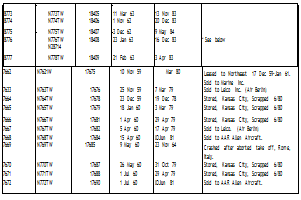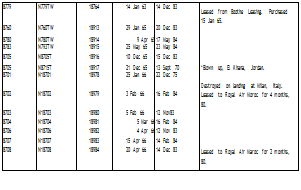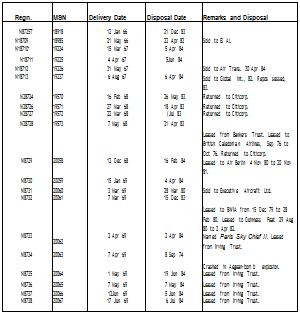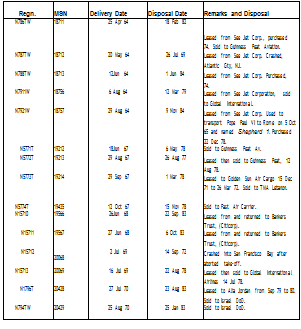A New Era
N73ITW
unnonmrmnoomon поооооооооОооп’ОдооздппгГГкпопа
This picture epitomizes the beginning of the Jet Age. T. W.A.’s Boeing 707-131 N731TW is pictured on the ramp at San Francisco early in 1959, and parked next to a United Air Lines Douglas DC-7, symbol of a former era. The handsome airport building does not yet have the air bridge
connection, and the crew stands ready with the mobile staircase.







‘ Nomed London Town and inaugurated Idlewild—Heathrow – Frankfurt service, 23 Nov 1959.
BOEING 707-33IB
(All aircraft sold to Boeing Military Airplane Co.)
* Cockpit was destroyed by a bomb in Damascus 29 Aug 69. New nose section built by Boeing and transported to Damascus ond installed. Reregistered as N28714 24 Dec 69 after threats to destroy tbe same aircraft were made.
BOEING 707-33IB (A)
(Except where noted, all sold to Boeing Military Airplane Co.) * Hijacked from Frankfurt, Germany 6 Sep 70.
* Flew JFK – O’Hare-Kansas City as T. W.A.’s last commercial 707 flight, 31 Oct 83.
BOEING 707-373C (H)
BOEING 707-338C (H)
BOEING 720-05IB
This Boeing 707-33IB (Advanced) had the new ‘outlined’
TRANS WORLD marking, and a revised logo style on the tail.
|
|
|
|


The 707 “Intercontinental” had a longer fuselage, larger improved wing, taller vertical fin, and a ventral fin below the tail. Note the ‘blow-in doors’ on the “Dyna-Fan” engine nacelles’ forward section.
Progressive Improvement
With the 707 series, Boeing became the world’s leader in airliner manufacturing. The classic Boeing 707 came in several forms. Initially, the -100 was a comfortable transcontinental airliner, but was limited across the Atlantic, having to stop at Gander or Shannon in the westbound direction. Its Pratt & Whitney JT4A-9 straight jet engines were known, rather unkindly, as the “Ole Smokies.” The -300, with JT3Cs and a slightly longer fuselage, was much better, and the -300B with JT3D turbofans and improved wing better still. The -331B(A-H) (Advanced – Heavy) had a heavy-duty landing gear, allowing a gross take-off weight up to 335,000 lb. They had more range, more capacity, and were more profitable than previous versions. The greater power enabled the -300 to be able to cut about half a mile from the take-off distance required by the other Boeings.
T. W.A.’s Decision
Having demonstrated considerable ingenuity and initiative, not to mention technical confidence, in launching its transcontinental jet service with a single Boeing 707-131 on 20 March 1959 (page 67). T. W.A. did not rush immediately to match Pan American on the trans-Atlantic route. It elected to await the availability of the longer-ranged -331, and meanwhile concentrated on expanding its domestic network so that T. W.A. Boeings were competing with American’s at all the major cities. Ultimately, the -331s were deployed on the New York-London-Frankfurt route on 23 November 1959. T. W.A. had lost a whole year to its archrival Pan American, and with other problems of a non-technical or operational nature, the airline had a long fight on its hands.
Engines Pratt & Whitney JT3D-3 (18,000 lb. thrust) x 4 Length 153 feet
MGT0W 335,0001b Span 146 feet
Range 4,000 miles Height 42 feet
|
|
The Smaller Boeings
To meet a requirement for routes of lower traffic density, Boeing produced a shorter-bodied version, the 720, 8 feet shorter than the -100, but with the same wing. T. W.A. also had one Series -138, which was 10 feet shorter than the basic type, and designed for the Australian airline QANTAS, with extra tankage for maximum trans-Pacific range. T. W.A. operated a total of 133 Boeing 707s, and made good use of them all over the world.











